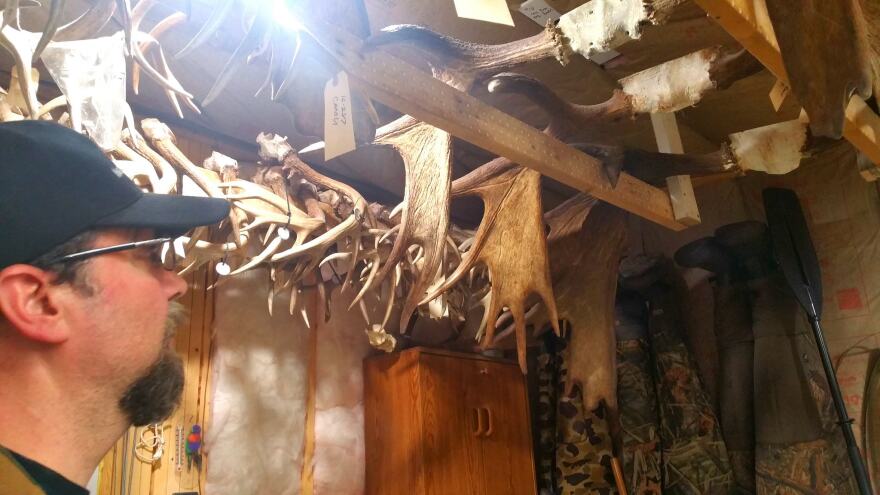Our next installment of Once Upon A Job takes us into a world of glass eyes, antlers, and hides. Taxidermy had its heyday during the Victorian era, when animals were hunted and made into parlor ornaments.
But in the 20th century, changing sensibilities, among other factors, led the profession into decline. Now though, the craft is experiencing something of a Renaissance.
“Once Upon a Job” is a series looking at some of the uncommon skills that are still being put to good use. In this installment, we travel to Dayton to meet a man who spends a lot of time looking through the freezer.
"So we got all kinds of stuff in here," says taxidermist Paul Reynolds. Reynolds is rooting through a large chest freezer at his studio in Dayton. The freezer is filled to the top with frosty hides, heads, and carcasses of varying description, each one a promised project for a client who will wait months for the finished product. "A turkey fan and beard that I have to do for a customer," he says, rummaging around, throwing frozen packages about. "I've got a black bear here, black bear skull for a European mount. We've got, in here, a little woodcock."

Business is good, but it hasn't always been so. One of the biggest factors, says Reynolds, is that taxidermy has become trendy in urban settings - in nouveau chophouses, meaderies, and craft brew pubs, appealing to millennials in a way it just didn't to their parents.
And he says it's not as hard as it once was to get into the profession. "I think a big problem with taxidermy is that the old guard, the old timers - I'm talking guys, and I'm 52 - when I was a young man, they just didn't want to pass on the knowledge, and they were very reluctant to tell people how they do things for fear of losing business."
Reynolds says as a youth he approached a master taxidermist in the area - one of the best bird mounters in the country, who refused to share his knowledge. So he signed up for a correspondence course advertised in the back of a hunting magazine.
After a lot of trial and error he started to get the hang of it. Now, 40 years on, his freezers are full, the orders keep coming. "I've got seven freezers full of projects right now. If a person walks in the door, I'm back about a year-and-a-half with work, and that's trying to get stuff done every day."

As Reynolds tries to find an assistant to help with the backlog of orders, he's also willing to share the skills of the trade with others.
Today Reynolds is teaching Tammy Cruciotti how to mount a sea duck onto a shore habitat. "It always seemed like a waste just to throw away the part, like skin or the hides or whatnot. Now I can put them to use -and they're memories," she says.
Cruciotti is an avid hunter and angler, who works in hospital radiology by day. But when she and her husband came in to Reynolds' shop to have a moose mounted, Cruciotti found what she says might be her next career.

"I started asking questions because I started looking at his stuff - I do painting at home," she says. "And I saw he had some stuff out. I think he might have been painting duck bills the day I came in and I became very interested and he offered - said he was very busy and asked if either of us were willing to learn taxidermy. I was like, yeah, I'd love to, and I think I started the very next week."
That was about nine months ago, and since then, Cruciotti has been learning the basics of the business, how to create realistic-looking habitats, to perfect the right form, drape the skin, and move it into place, how to hide little mistakes, add eyes, details, and place feathers one by one.

Taxidermy comes from two Greek words, taxis meaning "arrangement" and derma meaning "skin." So that stuffed deer you might see in a sporting goods store? There's nothing but a deer shaped form under there, which might be sculpted from styrofoam, or if it's an older mount, might be stuffed with excelsior and padding. The skins themselves are sent away to be custom tanned with the hair on.
Cruciotti has been working on her own project at home - a duck - but Reynolds says even if he's not around to answer a question she might have, Cruciotti can simply go online.
"You know, social media," he says. "And you've got YouTube, and there's so many people who put out videos how to do stuff. None of that was available when I started. I guess it's more proper to share information than it is to hold back now."
The entrance of women like Cruciotti into the taxidermy culture is another factor that's helping the profession to rebound, as is the rise of so-called "rogue taxidermy" - a mixed media art form that can incorporate real and artificial taxidermy components.
And for those who want to become a taxidermist in Maine, the state requires a license and application, and a $50 fee.
This story was originally published Aug. 25, 2017 at 4:18 p.m. ET.



